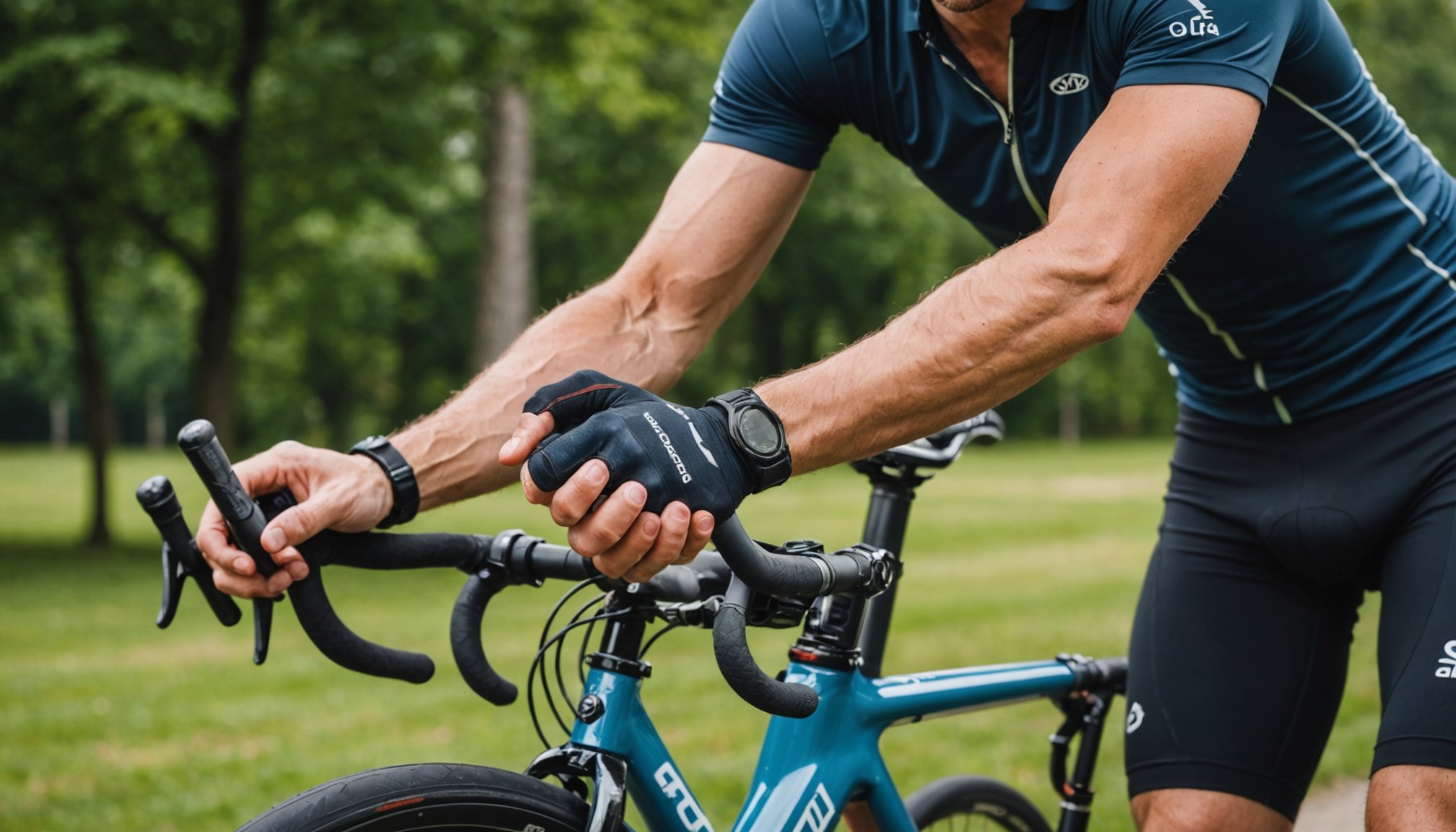Understanding Wrist Pain in Cyclists
Wrist pain can be a common challenge faced by cyclists, often stemming from cycling injuries. Cyclists may experience various types of wrist pain, including numbness, tingling, or sharp discomfort. These symptoms are typically linked to different cycling injuries, such as tendonitis or carpal tunnel syndrome. The repetitive motions and pressure applied to the wrists during long rides are frequent culprits.
Several factors contribute to wrist pain during cycling. The bicycle’s ergonomics play a pivotal role; improper handlebar height or positioning can lead to uneven weight distribution, thereby increasing strain on the wrists. Additionally, the lack of varying hand positions and inadequate cushioning on the handlebars can exacerbate the issue. Poor posture further adds to the strain, highlighting the importance of ergonomic awareness in preventing these injuries.
Also to see : Unlock Your HIIT Potential: The Best Breathing Techniques for Enhanced Performance
Addressing wrist pain is crucial not only for comfort but also for enhancing cycling performance. By incorporating ergonomic awareness into their routine, cyclists can minimize discomfort and potentially improve their riding efficiency. Regular adjustments to the bicycle setup and exploring different handle positions are recommended steps to reduce the risk of wrist pain, allowing for a more enjoyable and injury-free cycling experience.
Importance of Bike Fit
Ensuring a proper positioning on your bike can be pivotal in enhancing both comfort and performance while riding. A well-executed bike fit, especially in areas like saddle height, reach, and handlebar height, plays a critical role in warding off potential injuries. For instance, wrist pain often stems from incorrect bike fit, where an improper reach causes undue stress on the wrists. Adjusting the handlebars and saddle to match your physical dimensions can significantly alleviate this issue, thus enhancing your overall cycling experience.
This might interest you : Essential Nutritional Tactics for Bodybuilders During the Cutting Phase: Fuel Your Transformation
When determining the ideal bike fit, three primary measurements warrant attention. Firstly, the saddle height is crucial as it impacts pedalling efficiency and knee strain. Second, the reach, both to the handlebars and the pedals, must be comfortable to prevent hunching or overstretching the spine and arms. Lastly, handlebar height is often overlooked but is critical in ensuring a relaxed wrist posture and reducing the likelihood of discomfort or injury.
For those unsure about achieving the perfect bike fit, seeking professional bike fitting services can offer personalized adjustments tailored to your unique structure—catering to injury prevention and optimizing your ride. Such expertise ensures that all elements are harmonized for both safety and enjoyment.
Adjusting Handlebar Height
Handlebar height significantly affects your overall cycling experience, influencing both comfort and performance during rides. The right ergonomic setup can prevent wrist strain and enhance control while cycling. To achieve an optimal wrist position and avoid discomfort, it is vital to tailor the handlebar height to your specific needs.
Different cycling styles demand distinct handlebar heights for an ideal posture. For instance, competitive road cyclists often prefer lower handlebars for aerodynamic efficiency, whereas casual riders typically favour a higher position to maintain an upright posture and ease wrist tension. Understanding these nuances enables more tailored comfort adjustments to suit your cycling style.
Adjusting the handlebar height involves straightforward techniques that require basic tools like an Allen wrench or a hex key. Begin by loosening the bolts securing the handlebars and then adjust them to your desired height. After achieving the preferred level, ensure all bolts are securely tightened to maintain stability during rides.
Consistently checking the ergonomic setup can prevent future discomfort, keeping your cycling experience pleasant. With these adjustments, you can enjoy tailored comfort and improved control, enhancing both the longevity of your rides and your cycling experience.
Correct Wrist Positioning
Achieving proper wrist positioning is crucial for both comfort and efficiency. Maintaining a neutral wrist position can significantly reduce strain and prevent long-term injuries. This involves keeping your wrist straight, aligned with your forearm, allowing muscles and tendons to work in their optimal range without excessive bending.
Adopting the right hand grip techniques further enhances comfort. A key grip technique is to hold items lightly rather than squeezing them tightly. This reduces tension and serves to alleviate the potential for strain. Alternating between fingers when performing repetitive motions can also distribute pressure evenly, contributing to overall wrist health.
However, it’s common for individuals to make gripping mistakes that could lead to pain. One frequent error is excessive bending of the wrist, particularly upwards or downwards, which puts unnecessary stress on the tendons. Additionally, gripping objects with excessive force can lead to fatigue and discomfort. Awareness and adjustment of these habits can greatly contribute to wrist health.
Understanding and implementing these principles of wrist positioning and grip techniques is essential for ongoing comfort and the prevention of injuries. Making conscious choices about these habits will ensure long-term functionality and ease in daily tasks.
Stretching and Strengthening Exercises
To ensure optimal wrist health both before and after your ride, incorporating a series of dedicated stretching exercises is crucial. These exercises not only enhance wrist strength but also aid significantly in injury recovery.
Start with gentle stretches that target the forearm muscles, such as wrist flexor and extensor stretches. These are essential for maintaining flexibility and preventing strain. You might also engage in wrist rotations, which improve mobility and are beneficial in a routine pre-ride warm-up.
Once you’ve focused on stretching, it’s important to incorporate strengthening exercises that build wrist stability. Resistance band exercises, such as wrist curls and extensions, are effective for developing stronger wrists. Enhancing wrist strength is particularly useful for those involved in activities that require repetitive motion or weight-bearing, thus reducing the likelihood of future injuries.
Making routine stretching a part of your daily schedule is integral in preventing injuries. This practice not only preserves joint health but also promotes quicker recovery if an injury occurs. By maintaining a consistent stretching and strengthening routine, you’ll support overall wrist functionality and resilience.
Gear Recommendations for Wrist Health
When it comes to maintaining wrist health during cycling, investing in ergonomic equipment can make a significant difference. Ergonomic cycling gear is designed to promote comfort, reduce strain, and provide support, which is essential for both occasional cyclists and avid riders.
One of the most beneficial additions to your cycling setup is ergonomic grips. These specially designed grips help distribute pressure evenly across your hands and wrists, significantly reducing the chances of discomfort or injury. Protective accessories like wrist braces can also provide extra support, especially on long rides or rough terrains.
Furthermore, gloves with built-in wrist support or padding are invaluable. By absorbing shock and vibrations from the road, these gloves protect your wrists and enhance overall control. High-quality brands, such as Specialized or Giro, offer a range of products tailored for wrist support. Look for models that combine comfort with durability to ensure long-lasting protection while cycling.
Incorporating these equipment options into your cycling routine can be a game-changer, improving your performance and ensuring your wrists remain healthy. Remember, choosing ergonomic gear is not just about immediate comfort but also long-term health.
Common Mistakes Leading to Wrist Pain
When it comes to cycling mistakes that lead to wrist pain, bike setup is often a major culprit. Misalignments, such as incorrect handlebar height and poorly fitted grips, create uncomfortable pressure points. Ensuring your bike is fitted to your body can significantly contribute to wrist pain prevention. Adjustments in cycling ergonomics are crucial; a professional bike fit helps to distribute weight evenly, reducing unnecessary strain.
Another common error is neglecting warm-up and cooldown routines. These routines are pivotal in preparing the body for physical demands and promoting recovery. Including stretches that specifically target wrist and hand muscles will enhance wrist pain prevention. Those brief few minutes of stretching can make a significant difference in reducing vulnerability to injury.
Ignoring early warning signs of pain and strain in wrists is another mistake. Attention to initial discomfort can prevent long-term issues from developing. Cyclists should routinely check for signs of discomfort and modify their techniques or take breaks as needed. Listening to your body and adapting your cycling practices are crucial.
In summary, correcting cycling mistakes and emphasizing appropriate ergonomics, alongside proper warm-up and cooldown routines, can greatly aid in wrist pain prevention. Adapting these practices into one’s cycling habits can mitigate many issues associated with wrist discomfort.
Expert Insights on Wrist Pain Management
Obtaining professional recommendations on wrist pain management is essential for cyclists. Expert advice from cycling coaches and physical therapists is invaluable for injury prevention. For instance, many physical therapists stress the importance of proper hand positioning on handlebars to avoid strain. Adjusting your bike fit, such as saddle height and handlebar reach, can significantly reduce wrist pressure and prevent injuries.
It’s crucial to consult healthcare professionals when pain persists. Persistent wrist pain could indicate an underlying issue that may require targeted intervention. According to an experienced cycling coach, “Ignoring chronic pain can worsen the injury, making simple tasks challenging.”
Role of regular health check-ups cannot be overlooked in this context. They help in early detection of potential problems, ensuring timely management before escalation. A physical therapist emphasizes, “Regular assessments allow for tailored advice on adjustments and exercises to support wrist health.”
Here are a few expert tips:
- Maintain proper posture to distribute weight evenly.
- Incorporate wrist-strengthening exercises into your routine.
- Use padded gloves to reduce vibration and strain during rides.
Remember, prevention through expert guidance is key to enjoying cycling pain-free.






